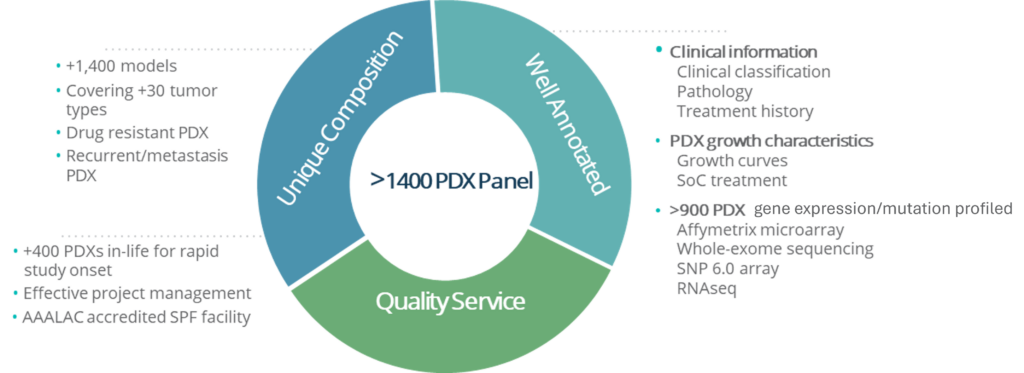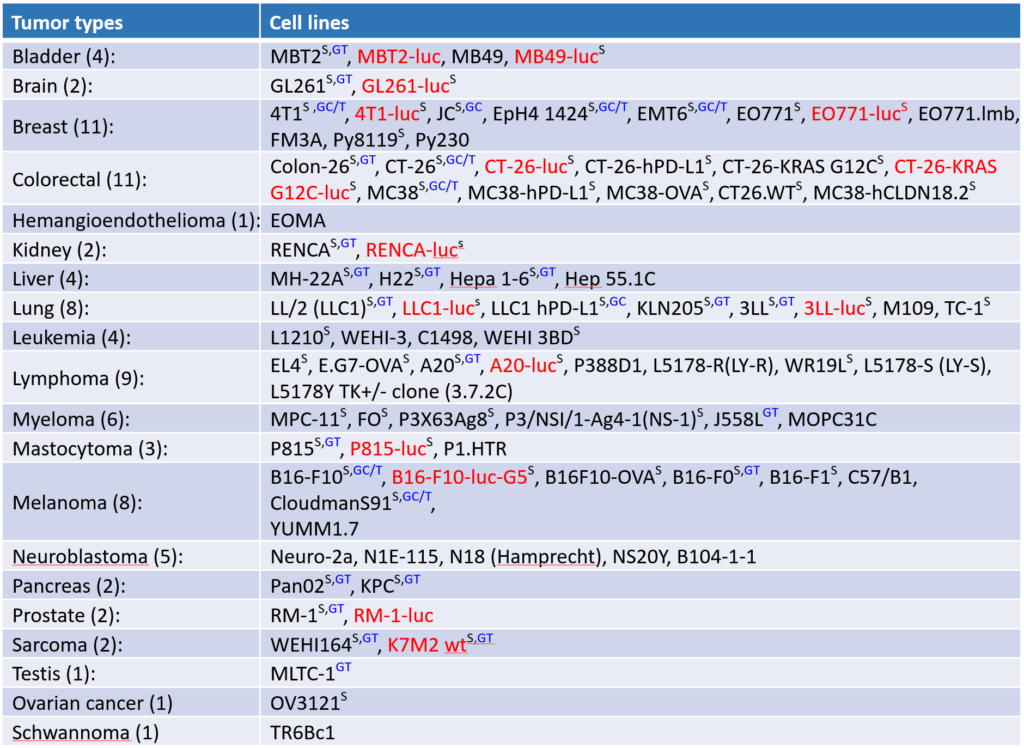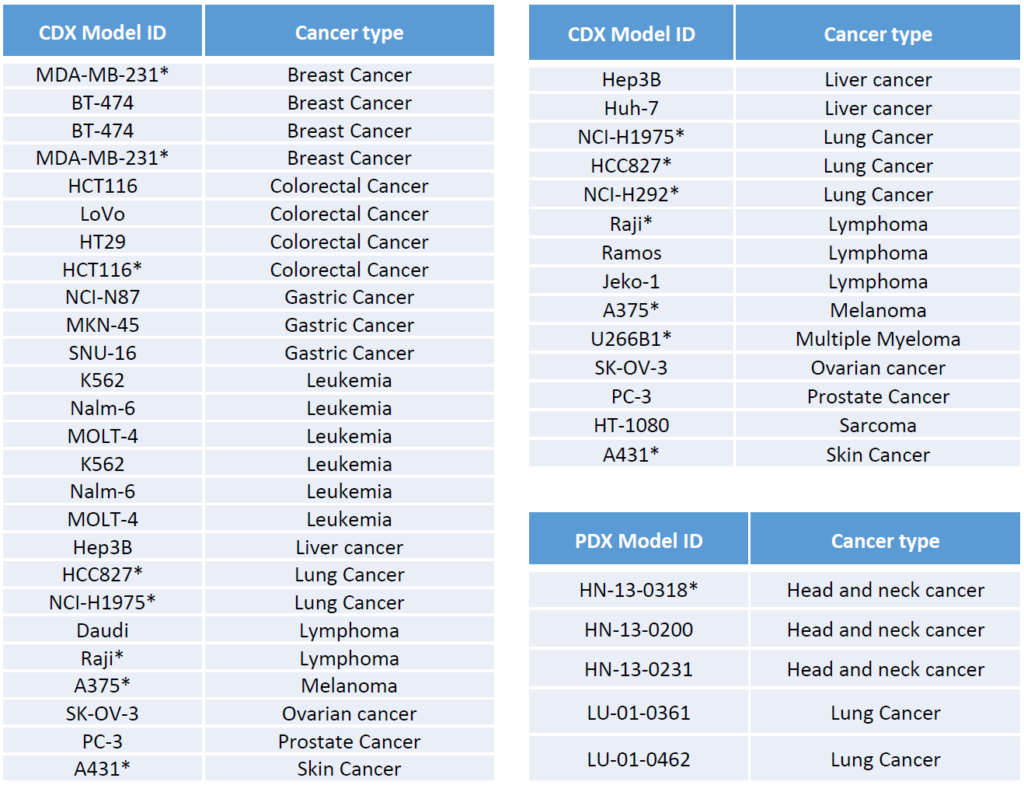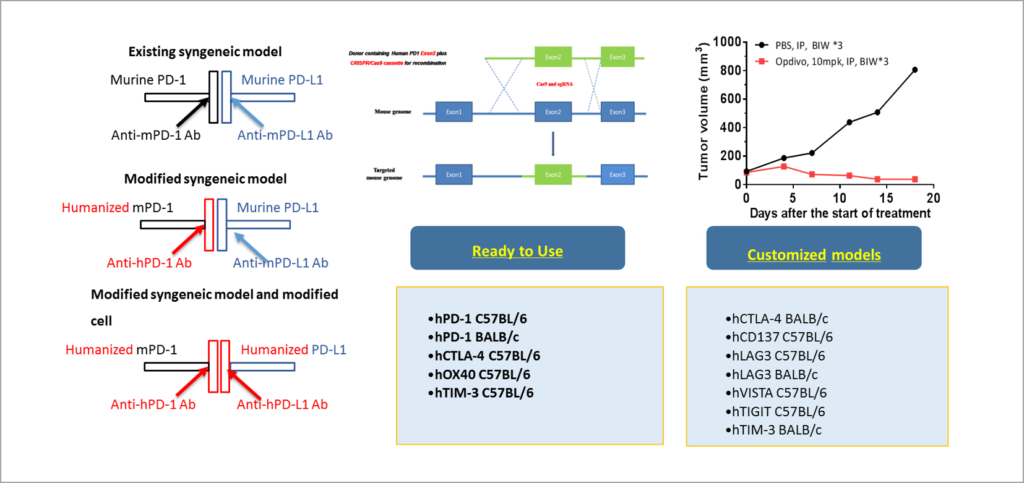Tumor Models for Small & Large Molecule Drug Discovery
WuXi Biology has a significant experience in oncology drug discovery. We offer a large collection and tumors model for small & large molecule drug discovery.

- A large collection of cell line-derived xenograft (CDX) tumor models covering 30 tumor types
- Imaging based orthotopic/metastatic CDX platform, covering 15 tumor types
- Patient-derived xenograft (PDX) tumor models covering 20 cancer types, drug resistant model and mouse clinical trial enabling translational research
- Syngeneic tumor models covering 20 cancer types, enabled with immunotherapy SOC, TIL analysis and RNAseq profiling.
- Human immune checkpoint gene KI mouse models
- hPBMC/HSC humanized models
- Extensive panel of c-MET related CDX and PDX tumor models
- In Vivo Models of Tumor Complications
Cell Line-derived Xenograft (CDX) Tumor Models
- 77+ cell lines derived from PDX models
- Available data of sensitivities to SOC (standard of care)
- Imaging-based orthotopic/metastatic tumor models
- Brain/bone metastatic models of lung/breast cancer cell lines
320+ Validated Models Covering 30 Tumor Types
Cancer Cell Line-Derived Xenograft (CDX)
| Bladder | T24/83*, RT112/84* , UM-UC-3*, J82*, HT1197, HT1376, 5637, NBT-II, KMBC-2, SW780, SCaBER, RT-4 |
| Brain | U87*, LN-229*, D283*, T98G*, U118MG*, SK-N-SH, Daoy |
| Breast | Cal51*, BT-474*, HCC1954*, MDA-MB-231*, MDA-MB-468*, HCC1806*, MCF7*, HCC1937, MDA-MB-436*, SUM-52PE, JIMT-1*, MDA-MB-361*, HCC-70*, SUM 159PT, T47D*, HCC1428, ZR-75-1*, MT-3, DU4475*, BT-20, MFM-223, HCC1187, HCC1569, HCC1599, BT-483, HCC1500, MDA-MB-453, SUM149PT, HCC38 |
| Cervical | SW756*, Ca Ski, ME180 |
| Cholangiocarcinoma | HuCCT1, RBE |
| Colorectal | Colo205*, HT29*, HCT-116*, HCT-15*, LS180* , LS174T*, SW620*, HT55*, DLD-1*, Lovo*, COLO-320DM, RKO, Caco-2, T84, WiDr, SW480*, SW 48, LS411N, COLO 201, GP2D, GP5D, SW837*, SW1463*, KM12*, Colo678, NCI-H508, HCT-8, RCM1, LS513, MDST8, LS1034, SW948 |
| Duodenal | HuTu80 |
| Esophageal | T.Tn, OE21*, EC9706*, OE19*, KYSE-520*, KYSE-150* |
| Endometrial | AN3 CA*, RL95-2, HEC-1 |
| Gastric | NUGC4*, SNU-1*, SNU-16*, MGC-803, NCI-N87*, SNU-5, MKN45*, HS 746T*, KATO-III*, HGC-27, GIST-T1*, AGS |
| Head & Neck | Cal 27*, RPMI2650, Fadu*, Detroit 562, HSC-2 |
| Leukemia | HEL 92.1.7*, MV4-11*, CCRF-CEM, HL-60*, K562*, KG-1, MOLT-4*, Kasumi-1*, Nalm-6*, THP-1, SET-2* ,PL-21, RS4;11*, MOLM-13*, MEG-01, KU812*, MOLM-14 |
| Liver | BEL-7404*, Hep3B*, Huh 7*, HepG2*, SNU-182, SNU-398, JHH-7*, MHCC97H*, SK-HEP-1*, Huh-1 |
| Lung | NCI-H1650, NCI-H226*, NCI-H460*, PC9*, A549*, Calu-1, Calu-6*, HCC1599, A427*, NCI-H647, MSTO-211H, NCI-H292*, NCI-H322, NCI-H358*, NCI-H441*, NCI-H520, NCI-H1975*, NCI-H2228*, SK-MES-1, NCI-H1299, HCC-827*, HCC4006, NCI-H1703, NCI-H727, NCI-H2122*, DV-90, NCI-H69*, NCI-H1417*, NCI-H446, NCI-H526*, NCI-H82, SHP-77 , Calu-3*, NCI-H2170*, NCI-H820*, NCI-H23*, NCI-H1568, NCI-H1944, NCI-H2023, NCI-H2030*, NCI-H2126, NCI-H838, NCI-H1838*, DMS114*, NCI-H211*, NCI-H209*, NCI-H2286*, NCI-H596, HCC15, HCC44*, NCI-H1373*, SW1573, LCLC-97TM1, HCC1588, NCI-H1048, NCI-H1581, NCI-H1781, NCI-H1963, COLO699, NCI-H2135, EBC-1*, NCI-H2172, LU99, DMS53,NCI-H1155, NCI-H1355, NCI-H1395, NCI-H522, NCI-H650, SW900, NCI-H1993*, NCI-H2110, NCI-H146*, NCI-H1623, NCI-H1770, NCI-H2347 |
| Lung (small cell) | NCI-H69*, NCI-H1417*, NCI-H446, NCI-H526*, NCI-H82, SHP-77, DMS114*, NCI-H211*, NCI-H209*, NCI-H2286, NCI-1048, NCI-H1963 |
| Lymphoma | Daudi*, SU-DHL-2*, SU-DHL-4*, SU-DHL-6, SU-DHL-10, Granta-519*, Maver-1*, Mino*, NAMALWA, Raji*, Ramos*, RL, WSU-DLCL2*, Z-138, U937, DoHH2*, Farage*, Pfeiffer*, REC-1*, Toledo, HuT78*, JeKo-1, CCRF-SB (ALL) *, SU-DHL-1, OCI-LY3, HBL-1*, OCI-LY7, KARPAS299*, HH, H9, KARPAS-422, SUPT1 |
| Melanoma | A375*, SK-MEL-24, SK-MEL-28, COLO 829*, SK-MEL-5 , MDA-MB-435S, MeWo, SK-MEL-3, A2058*, MP41, SK-MEL-2 |
| Mesothelioma cancer | NCI-H226*, MSTO-211H |
| Myeloma | KMS-28BM, KMS-11, MOLP-8*, NCI-H929*, RPMI 8226*, MM.1S*, OPM-2*, MM.1R |
| Nasopharyngeal | C666-1 |
| Neuroblastoma | CHP-134*, SK-N-AS*, BE(2)-C* |
| Ovary | A2780*, SK-OV-3*, ES-2*, OVCAR-3*, TOV21G, OV90*, TOV112D, PA-1, CAOV3 |
| Pancreas | BxPC3*, Mia-pa-ca-2*, KP4*, PANC-1*, CAPAN-1*, Panc 02.13*, AsPC-1, HPAC*, HPAFII, CFPAC-1, Panc 04.03 CAPAN-2, Mia-pa-ca-2 hCLDN18.2, Hs766T, SW1990 |
| Prostate | PC-3*, DU145*, LNCap*, VCaP* , 22RV.1*, C4-2*, C4-2B* |
| Renal | 786-O*, ACHN, Caki-1, SK-NEP-1, A498 |
| Sarcoma | HT1080, A673, KHOS/NP, 143B, SJSA-1*, SAOS-2, A204, G401, Aska-SS, HS-SY-II , Yamato-SS, SJCRH30, SK-ES-1 |
| Skin | A431*, MKL-1 |
| Testicular Embryonal | NEC14 |
| Thyroid | TT*, FTC-238*, 8505C, xSW579 |
| Uterine | MFE-280, SK-UT1 |
55 Experimental Metastasis Xenograft Models Covering 8 Tumor Types
Metastasis Xenograft Models
| Cancer types | Cell lines | Inoculation site | Metastatic /target organs | Model types |
| Brain | SK-N-SH-luc | Intra-venous | Multiple sites | Metastasis |
| Breast | MCF7-luc, MDA-MB-231-luc-D3H2LN, HCC1954-lucS, MDA-MB-436-luc, xxT47D-luc | Intra-cranial | Brain | Ectopic |
| JIMT-1-lucS, HCC1954-lucS | Intra-carotid | Brain | Metastasis | |
| MDA-MB-231-luc-D3H2LN | Intra-cardiac | Multiple sites | Metastasis | |
| JIMT-1-luc, HCC1954-lucS, MDA-MB-231-luc-D3H2LN, MDA-MB-436-luc, HCC1806-luc | Intra-venous | Lung | Metastasis | |
| MCF-7-lucS, MDA-MB-231-luc, HCC1954-luc | Intra-osseous | Bone | Ectopic | |
| MCF-7-lucS, MDA-MB-231-luc-D3H2LN, JIMT-1-luc-gfp | Intra-caudal arterial | Bone | Metastasis | |
| MDA-MB-231-luc | Intra-peritoneal | Multiple sites | Metastasis | |
| Colon | SW620-luc | Intra-liver | Ectopic | |
| Gastric | NCI-N87-lucS | Intra-cranial | Brain | Metastasis |
| Lung | NCI-H1975-lucS, NCI-H2228-luc, NCI-H441-luc, NCI-H460-luc2, PC-9-lucS, PC-9 EGFR DTC-lucS , NCI-H1703-luc, NCI-H2122-luc Clone-16-11, NCI-H1373-luc, LU-01-0426 | Intra-cranial | Brain | Ectopic |
| NCI-H1373-lucS, NCI-H1975-lucS, NCI-H2122-luc, PC-9-lucS, NCI-H292-luc | Intra-carotid | Brain | Metastasis | |
| PC-9-luc-BR (in vivo selected “brain-seeking” cell line) S | Intra-cardiac | Brain | Metastasis | |
| NCI-H292-luc, HCC827-luc | Intra-venous | Multiple sites | Metastasis | |
| NCI-H1373-luc, NCI-H358-luc | Intra-osseous | Bone | Ectopic | |
| Melanoma | SK-MEL-3-luc, SK-MEL-5-luc, SK-MEL-24-luc, SK-MEL-28-luc, A375-luc | Intra-cranial | Brain | Ectopic |
| Pancreas | MIA-PaCa-2-luc, AMG510-R-xMiaPaCa-2-luc, ASPC-1-luc | Intra-cranial | Brain | Ectopic |
| ASPC-1-luc | Intra-carotid | Brain | Metastasis | |
| Prostate | PC-3M-lucS | Intra-osseous | Bone | Ectopic |
| PC-3M-luc | Intra-caudal arterial | Bone | Metastasis |
46 Orthotopic/Disseminated Tumor Models Covering 15 Tumor Types
Organ-based Orthotopic Models of Solid Tumor Cell Lines
| Breast | MCF7-luc, MDA-MB-231-luc-D3H2LNS, HCC1954-luc |
| Colorectal | Colo205-luc2, HT29-luc2, HCT-116-luc2 |
| Duodenal | HuTu80-luc |
| Gastric | MGC-803-luc , NCI-N87-lucS |
| Liver | Hep3B-lucS, HepG2-lucS, BEL-7404-lucS |
| Lung | A549-luc, NCI-H460-luc2 |
| Ovarian | A2780-cp-luc, SK-OV-3-luc |
| Pancreas | BxPC3-luc2, MIA-PaCa-2-lucS , AsPC-1-luc, PANC-1-luc |
| Prostate | LNCaP-luc2, PC-3M-luc2S, LNCap.FGC-luc |
| Renal | ACHN-luc2, 786-O-luc |
| Sarcoma | HT1080-luc2, 143B-luc |
IV Injection Disseminated Models of Hematopoietic Cancer Cell Lines
| Leukemia | K562-luc-GFP, MOLT-4-luc2, Nalm-6-luc, MOLM13-lucS, THP-1-luc, MV4-11-lucS , HL-60-luc |
| Lymphoma | OCI-LY7-luc, Raji-luc, Raji-hPD-L1-luc, Mino, JEKO-1,MM.1S-luc |
| Myeloma | RPMI-8226-luc |
Patient-derived Xenograft (PDX) Tumor Models

- 1,400+ PDX models covering full range of cancer types
- Fully-characterized models with genetic, molecular and pharmacological profiling
- Drug-resistant models, including a clinical acquired capmatinib-resistant LU-01-0751 lung cancer PDX model
- in vitro screening and derivative PDXC/PDXO models
- IO-PDX panel with hPBMC humanization
Cancer Patient Derived Xenograft (PDX) Platform
| Tumor Type | Profiled | Established |
| Breast cancer | 23 | 27 |
| Cervical cancer | 4 | 7 |
| Cholangiocarcinoma | 35 | 42 |
| Colorectal cancer | 107 | 133 |
| Cervical cancer | 4 | 7 |
| Endometrial cancer | 4 | 4 |
| Esophageal cancer | 60 | 83 |
| Gallbladder cancer | 8 | 10 |
| Gastric cancer | 70 | 101 |
| HCC | 119 | 230 |
| Kidney cancer | 24 | 36 |
| Leiomyosarcoma | 4 | 4 |
| Lung cancer | NSCLC | ACD | 83 | 99 |
| Lung cancer | NSCLC | SCC | 129 | 138 |
| Lung cancer | NSCLC | ASC | 9 | 9 |
| Lung cancer | NSCLC | Large cell | 3 | 3 |
| Lung cancer | SCLC | 15 | 21 |
| Lung cancer | Other | 21 | 86 |
| Lymphoma | 47 | 51 |
| Melanoma | 16 | 23 |
| Nasopharyngeal carcinoma | 20 | 32 |
| Osteosarcoma | 18 | 23 |
| Ovarian cancer | 11 | 18 |
| Pancreatic cancer | 54 | 56 |
| Urothelial carcinoma | 7 | 7 |
| Uveal melanoma | 1 | 1 |
| Thyroid cancer | 1 | 1 |
Cancer Patient Derived Xenograft (PDX) Platform
| Tumor Type | Profiled | Established |
| Breast cancer | 23 | 27 |
| Cervical cancer | 4 | 7 |
| Cholangiocarcinoma | 35 | 42 |
| Colorectal cancer | 107 | 133 |
| Cervical cancer | 4 | 7 |
| Endometrial cancer | 4 | 4 |
| Esophageal cancer | 60 | 83 |
| Gallbladder cancer | 8 | 10 |
| Gastric cancer | 70 | 101 |
| HCC | 119 | 230 |
| Kidney cancer | 24 | 36 |
| Leiomyosarcoma | 4 | 4 |
| Lung cancer | NSCLC | ACD | 83 | 99 |
| Lung cancer | NSCLC | SCC | 129 | 138 |
| Lung cancer | NSCLC | ASC | 9 | 9 |
| Lung cancer | NSCLC | Large cell | 3 | 3 |
| Lung cancer | SCLC | 15 | 21 |
| Lung cancer | Other | 21 | 86 |
| Lymphoma | 47 | 51 |
| Melanoma | 16 | 23 |
| Nasopharyngeal carcinoma | 20 | 32 |
| Osteosarcoma | 18 | 23 |
| Ovarian cancer | 11 | 18 |
| Pancreatic cancer | 54 | 56 |
| Urothelial carcinoma | 7 | 7 |
| Uveal melanoma | 1 | 1 |
| Thyroid cancer | 1 | 1 |
Syngeneic tumor models
- 87 Syngeneic models (mouse, rat, hamster) covering 20 cancer types
- Comprehensive panel of orthotopic syngeneic tumor models
- Responsiveness to immune checkpoint inhibitors (PD-1, PD-L1, CTLA-4, etc.)
- Tumor-infiltrating leukocytes (TILs) map
- WES, RNA-seq and scRNA-seq characterization

Genetically engineered models
- 48 engineered cell lines based on construct overexpression or gene knock-in
- Pharmacologically validated both in vitro and in vivo
- Focusing on drug-resistant mutation introduction and IO-related checkpoint humanization
- Example targets: EGFR, ROS1, ALK, RET, FLT3, BTK, Claudin18.2, PD-L1
hPBMC/HSC Humanized Models
hPBMC Humanized Models
- Established models for immune-checkpoint inhibitor and bi-specific antibody candidates in a human-resembling immune system.
- Annotation for both immune cells (phenotyping, biomarker, functions) and tumor cells (expression, mutation)
- Different PBMC delivery systems (systemic injection or co-inoculation with tumor)
HSC Humanized Models
- Available humanized models from CIEA, combined with WuXi PDX/CDX models.
- Customizable with human cytokine transgenic mice (GM-CSF/hIL-3 or hIL-2) to improve the reconstitution of myeloid lineage.
Established CDX/PDX-hPBMC Models

Human immune checkpoint gene KI mouse models
KI (Knock-in) mice offer the possibility to study clinical grade checkpoint antibodies targeting human checkpoints in the context of a fully functional immune system. WuXi Biology offers efficacy studies in different mouse strains with human targets KI in mice and cell line, and comprehensive flow cytometry to evaluate target expression and immune function.
- Collection of various targets and background mouse strains
- Validated with launched or most advanced clinical grade checkpoint antibodies
- Double checkpoint KI mice customizable for combination (PD1 + OX40, PD1 + TIM3)

Immuno-avatar humanized models
- Mouse models harboring human tumor and human immune ceils
- Three different diagram of hPBMC humanization for mature T cell engraftment
- HSC (CD34+) avatar and next generation immune avatar for multiple-lineage engraftment (Myeloid, NK, DC)
- IO-CDX and IO-PDX models with cancer targets and HLA information
Drug-resistant models
- Engineered cell line derived xenograft models
- Acquired drug-resistant CDX and PDX models
- Intrinsic drug-resistant PDX models
- Resistant models harboring specific oncogenic drivers
- KRAS G12C drug resistant tumor models
- Extensive panel of CDK4/6 inhibitor resistant breast cancer models
- Clinical acquired capmatinib-resistant LU-01-0751 lung cancer PDX model
- Enzalutamide-resistant (LNCAP AR-F877L) mutation KI prostate cancer model
- Osimertinib-resistant cell lines and mouse models
Related Resources View All
Orthotopic and Metastasis Tumor Models in Rats
Resource Type: Latest Science Presentation
Armoring CAR-T Therapy with PD-1 Blockade
Resource Type: Latest Science Poster
OncoWuXi Express: PSMA Overexpressing PC3 Tumor Model
Resource Type: Article Blog
AACR 2024 Posters: Sneak Peek
Resource Type: Article Blog
T-DXd Resistant Tumor Models with ABCG2
Resource Type: Presentation
OncoWuXi Express: Adenovirus Vaccine AD5-HPV Inhibits Tumor Growth by Stimulating...
Resource Type: Article Blog Case Study

